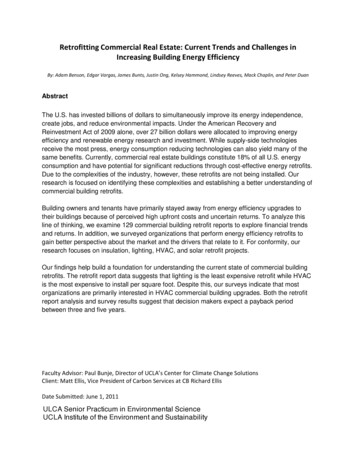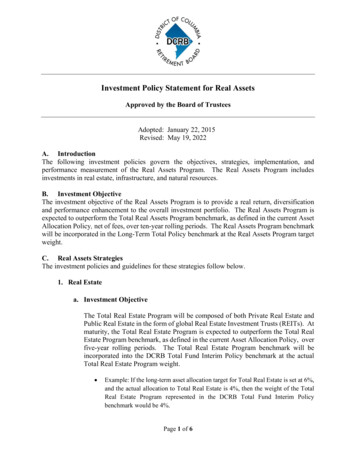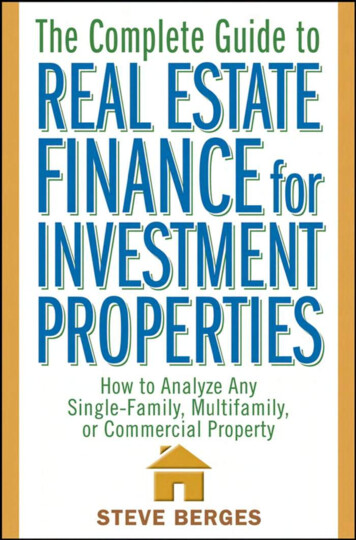
Transcription
Retrofitting Commercial Real Estate: Current Trends and Challenges inIncreasing Building Energy EfficiencyBy: Adam Benson, Edgar Vargas, James Bunts, Justin Ong, Kelsey Hammond, Lindsey Reeves, Mack Chaplin, and Peter DuanAbstractThe U.S. has invested billions of dollars to simultaneously improve its energy independence,create jobs, and reduce environmental impacts. Under the American Recovery andReinvestment Act of 2009 alone, over 27 billion dollars were allocated to improving energyefficiency and renewable energy research and investment. While supply-side technologiesreceive the most press, energy consumption reducing technologies can also yield many of thesame benefits. Currently, commercial real estate buildings constitute 18% of all U.S. energyconsumption and have potential for significant reductions through cost-effective energy retrofits.Due to the complexities of the industry, however, these retrofits are not being installed. Ourresearch is focused on identifying these complexities and establishing a better understanding ofcommercial building retrofits.Building owners and tenants have primarily stayed away from energy efficiency upgrades totheir buildings because of perceived high upfront costs and uncertain returns. To analyze thisline of thinking, we examine 129 commercial building retrofit reports to explore financial trendsand returns. In addition, we surveyed organizations that perform energy efficiency retrofits togain better perspective about the market and the drivers that relate to it. For conformity, ourresearch focuses on insulation, lighting, HVAC, and solar retrofit projects.Our findings help build a foundation for understanding the current state of commercial buildingretrofits. The retrofit report data suggests that lighting is the least expensive retrofit while HVACis the most expensive to install per square foot. Despite this, our surveys indicate that mostorganizations are primarily interested in HVAC commercial building upgrades. Both the retrofitreport analysis and survey results suggest that decision makers expect a payback periodbetween three and five years.Faculty Advisor: Paul Bunje, Director of UCLA’s Center for Climate Change SolutionsClient: Matt Ellis, Vice President of Carbon Services at CB Richard EllisDate Submitted: June 1, 2011ULCA Senior Practicum in Environmental ScienceUCLA Institute of the Environment and Sustainability
Table of ContentsBackground . 1Context . 2Technology and Retrofits . 3Government Incentives . 4Profit Sharing and Commercial Leases. 5Energy Service Companies (ESCOs) . 6Research Gaps . 7Objectives and Methodology . 9Objectives. 9Case Study vs. Retrofit Reports . 9Methodology . 10Expectations . 12Results. 13Meta-Analysis. 13Graphical Results. 14Spatial Analysis. 18Discussion . 25Review . 25Challenges . 28Resolutions . 29Recommendations . 35Implications of Future Policy. 38Conclusion . 42Bibliography. 44Appendices . 49
I.BACKGROUNDWith rising energy costs and the impetus to reduce greenhouse gas emissions, modernizingU.S. electric infrastructure and modifying current means of energy consumption have become ahot topic for politicians, business leaders, and academics alike. Often overlooked in favor ofsupply-side technologies (i.e. nuclear and wind power), energy reducing building retrofits canalso yield many of the same supply-side benefits.This is especially true for the commercial real estate sector as U.S. commercial buildings aloneaccount for a fifth of total domestic energy consumption or approximately 100 billion USD inannual power costs (EIA 2006). Research has identified that the average U.S. commercialbuilding has the potential to reduce its energy costs by approximately 22% through energyefficiency retrofits because most were built prior to 1990 and still use outdated, energyinefficient technologies and building materials (EIA 2006). Through a diverse set of commercialbuilding retrofit options, owners can cost-effectively reduce their building‘s energy consumptionand environmental footprint. Despite these benefits, retrofit projects are still only slowly beingimplemented. The problem? Decision makers, such as building owners and tenants, have fewresources to value a retrofit. This is especially true since retrofit returns are unique to eachbuilding and depend on local factors such as subsidies and electricity costs. Furthermore, theproprietary nature of commercial building contracts exacerbate the lack of public commercialretrofit data. This paper attempts to (1) frame the current roadblocks to commercial real estateretrofits, (2) identify areas of future study, (3) provide recommendations for policy makers andcommercial building property affiliates.This research paper is designed to expand the general knowledge of energy efficiency in thecommercial real estate sector. In particular, we hope our paper will frame realistic expectationsfor commercial building retrofits to start a path toward more retrofit-friendly policies andcontracts. Our initial research goal was to analyze the energy consumption of previouslyretrofitted buildings by lease structure, electricity price, finance methods, and retrofit type. Wediscovered that current public retrofit data did not provide sufficient details to analyze energyefficiency and commercial real estate in this way. For example, it was not feasible to explore therole of lease agreements in much depth due to their proprietary nature. Thus our goal becameto provide a basis for future analyses of commercial energy efficiency retrofits. To do this, basicpost-retrofit data was compiled from 129 industry and academic retrofit reports (Appendix E).We also consulted representatives from energy service companies (ESCOs), utility companies,and academic professionals to support our retrofit report data. Additionally, a template wasdeveloped for future studies to evaluate completed retrofits. The complete spreadsheet isavailable from the Institute of the Environment and Sustainability department web page at theUniversity of California at Los Angeles (UCLA).Based on our research experience, the main obstacle to retrofits is the proprietary nature ofcommercial building energy consumption. The information sharing problem can be rooted backto the nondisclosure agreements in most commercial building lease structures. As a result ofnondisclosure agreements, the results from successful retrofit projects are rarely reported. Many1
commercial leases have another characteristic that hinders retrofit implementation. Under aconventional lease, the tenant pays the majority of the operational costs such as lighting andclimate control. Therefore, owners have little incentive to retrofit their building‘s infrastructurebecause the savings would be primarily realized by the tenant. The problem is known inliterature as the ―split incentive‖. Since little post-retrofit data exists, prospective owners andtenants have little benefit data to weigh against retrofit costs. It is unsurprising then thatapproximately two-thirds of owners and tenants cited high first costs as a significant challengeto a green retrofit (McGraw-Hill 25). This underscores the importance to publish the costs andsavings of completed retrofits to reduce uncertainty and encourage property owners to makerational retrofit decisions.ContextThe energy infrastructure of a building is rarely upgraded after the initial construction (Kats2003) although the benefits of retrofits are financially appealing to both property owners andtenants. Property owners benefit from increased property values, reduced electricity costs, andrent premiums (Kats 2003). Similarly, tenants benefit from reduced electricity costs and, in somecases, improved worker productivity. Specifically, direct financial benefits were identified as theprimary motivations to retrofit a building (McGraw-Hill 2009). Despite these benefits, decisionmakers often choose not to make energy efficient upgrades because of perceived high up-frontcosts (Langdon 2007). For this reason, we expected that the profit-driven investment goalswould dictate retrofit decisions: the most popular retrofits would have low payback periods (andless risk) and high return on investments (ROI).Funding is also a barrier to retrofits. Even if a building owner or tenant wants to install a retrofit,finding funding to do it is not a simple process. Most lenders do not have the expertise toperform an audit needed to develop fair rates or contract terms. Furthermore, the 2008 financialcrisis has resulted in credit restrictions. As a result, retrofits are primarily being funded by onlythose with large pocketbooks: evidenced by company profits being the primary funding sourcefor green retrofits (McGraw-Hill 2009).The most common retrofits promote better insulation, optimized building management, andmodern lighting technology (Kok 2010). Our project focuses on retrofits related to these threevariables. One reason why these retrofit types are the most common is because they produceROIs and are easily installed (Kok 2010). We also included rooftop solar panel installations inour analysis to compare how the popular technology compared with the more fundamentalretrofit types. We felt that including solar was important, as many public and private resourcesare devoted to rooftop solar installations.Environmental benefits are also associated with reduced energy consumption. For example, theaverage building certified by the United States Green Building Council‘s (USGBC) Leadership inEnergy and Environmental Design (LEED) rating system uses 32 percent less electricityresulting in approximately 350 fewer metric tons of carbon dioxide emissions (Deloitte &2
Lockwood 2008). In another study, the simple replacement of single glazed windows withdouble glazed windows resulted in the reduction of natural gas and heating and electricalcooling energy consumption by more than 10 percent (Martin 2008). Considering the sheervolume of building energy use, small changes can aggregate to significant environmental andeconomic benefits.Technology and RetrofitsSince decision makers are concerned with the large upfront capital needed for retrofitinstallations, it is important to explore the long-term benefits of energy efficient technologiesfrom a cost-benefit perspective. One of the largest barriers that impedes the adoption of energyefficient retrofits in commercial properties is the building owners‘ false belief that energy retrofitsare too expensive. Contrary to this belief, empirical evidence shows that green retrofits are oftenprofitable (Binkley 2007).The most common tools used for energy efficiency include energy efficient technologies forheating and air conditioning systems, improved insulation, and the use of more natural lighting.These retrofit options are often considered due to simple installation and proven monetaryreturns (Bonda 2007). Nevertheless, the benefits from retrofit technologies are ambiguous to itskey stakeholders. The ROI of each retrofit technology depends on a multitude of variablesincluding the current state of the building, the specific technology implemented, and theavailable financial incentives. Expectations vary widely on what types of retrofits offer thehighest returns on their investments. In addition, owners of buildings may not know that manyutility companies offer free or inexpensive energy audit (Binkley 2007).LightingBuildings that use excessive or inefficient lighting systems may implement lighting systemupgrades that range from simple changes to a complete replacement. Occupancy sensors andtime clocks are examples of simple energy saving controls that can automatically reduce hoursof lighting. LED technology is another lighting retrofit that provides significant energy savings ofup to 70 percent over time, making the replacement worthwhile.Heating, Ventilation, and Air Conditioning (HVAC)A HVAC system provides buildings with adequate air flow, heating, and cooling. A relatively newtechnology, the continuous environmental management systems (EMS) can be installed tomonitor energy use and automatically adjust temperature settings accordingly. Within eachHVAC system, there is a set of components that could be also be improved. For example inone system, an old boiler, furnace, and heat pump can be improved to increase energyefficiency.InsulationInsulation upgrades including weather stripping, weather sealing, and the replacement of olddoors and windows with high-performance versions, also provide improvements with a quick3
payback period. Upgrading windows may also increase personal comfort and productivity byreducing drafts and noise, attracting more occupants for residential buildings in large cities, andproviding employees with a work-conducive environment (Katz 2008).Rooftop Solar (Photovoltaics)Rooftop solar panels directly convert the sun‘s radiation to electricity. Solar panels produce fewemissions and require minimal maintenance beyond the initial installation. Solar power is alsothe only type of retrofit that adds to a building‘s energy supply, rather than reduce energyconsumption in our study. The main drawback of rooftop photovoltaic power is that it is widelyrecognized as the most expensive type of renewable energy.Government Financial IncentivesThe government provides a large source of financial backing for energy efficient projects.Monetary incentives for commercial retrofits have been established at the federal, state, andlocal levels. These incentives make energy efficient retrofit projects more feasible to pursue.The Energy Policy Act of 2005 awards tax deductions to building owners who install interiorlighting, building envelopes, hot water, heating, cooling, and ventilation systems (DSIRE).Corporations can also benefit from the Business Energy Investment Tax Credit by beingawarded up to 30% of expenditures for the installation of renewable energy technologies(DSIRE). More recently, the American Recovery and Reinvestment Act of 2009 modified andexpanded the government incentives set forth in Energy Policy Act and designated 12 billiondollars for energy efficiency programs and projects. The Recovery Act has allocated 37 millionfor efficient lighting projects and over 76 million for advanced energy efficiency projects (ARRA2009).Three specific subsections of the Recovery Act are particularly relevant to the commercial realestate sector: the Energy Efficiency and Conservation Block Grants, the Butter BuildingsInitiative, and the State Energy Program. The Energy Efficiency and Conservation Block Grant(EECBG) Program has a total of 3.2 billion to allocate to energy efficiency and conservationprograms and projects, including commercial real estate (ARRA 2009). The Better BuildingsProgram creates tax deductions and provides more financing opportunities for building retrofits,with the ultimate goal of a 20% increase in energy efficiency in buildings by 2020 (ARRA 2009).Under the State Energy Program, the California Energy Commission has allocated 226 millionto disperse for energy efficient programs and projects (CEC 2011). More legislation is beingsent through Congress to continue and expand upon such established federal incentives(USGBC 2011).At the local level, many municipalities have taken measures to simplify the process and developfinancial incentives for energy efficient installations from federal funding. Specifically, localmunicipalities have reduced or waived permitting fees, expedited the permitting process,provided tax deductions, offered revolving loan funds or grants, as well as technical and4
marketing assistance (USGBC 2011). Local utility companies have also created programs toincentivize commercial retrofits. In particular, the Los Angeles Department of Water and Power(LADWP) offers programs to encourage retrofits among the commercial real estate industry.The available programs and available government capital is favorable for the commercial realestate industry, yet is not seen to be utilized or documented in current research of the industry.The PACE BondOne popular type of local incentive is called a PACE bond. Within two years of the first PACEbond, states had already applied for 80M of federal funds to supplement their own PACEprograms (ULI 27). A PACE bond has the basic structure of a typical government issued bond:in exchange for immediate cash, the government repays the borrowed money plus interest aftera predetermined number of years. Bond revenues normally finance public goods such asbridges and dam construction. In this respect, PACE bonds are unique because PACE bondrevenues are invested in private property in the form of solar panels and other energy efficiencyupgrades. They are also ‗revolving‘ – meaning that instead of a one-time payment like asubsidy, the initial investment is eventually recouped by the government. PACE bonds wereoriginally developed in 2007 to allow Berkeley residents to install solar panels on their homes.Few homeowners had sufficient money to pay for a 20,000 photovoltaic system upfront eventhough the expected energy savings from installation would exceed 20,000 over a 20 yearperiod (Jenkins 2009). PACE bonds allow these future energy savings to finance the initialupfront cost of the photovoltaic system. Applying PACE bonds to commercial real estate, theinitial investment would finance a retrofit such as new insulation and ventilation systems insteadof a solar panel.Property owners must consult their mortgage broker before they can enroll in a PACE program.In order to reduce risk (and lower interest rates), the property tax increases derived from PACEprograms are given a special priority termed a lien. The lien ensures the PACE program will bepaid before other lenders if the property owner were to default on their payments (Timiraos2010). Although liens have been used to fund local projects, brokers have especially weary oftheir application to PACE bonds. As a major setback to PACE bonds, a large governmentbacked mortgage broker, Fannie and Freddie Mac, announced that it will not allow any of theproperties financed to use PACE bonds. In response, a PACE pilot program consisting of300,000 homes has been proposed by Congress (Hiskes 2010). The PACE setback is oneprominent example of how risk can hinder retrofits.Profit Sharing & LeasesLease agreements form the backbone of commercial real estate business. The terms agreedupon in the lease contract determine both the financial and maintenance responsibilities of thetenant and the owner. Thus, understanding the logistics of lease agreements is essential inorder to implement energy efficient retrofits. A lease contract is an agreement made betweenthe owner of the building or landlord, who is the lessor, and the tenant, who is the lessee. Thiscontract validates the tenant‘s use of the owner‘s property to operate his/her business in5
exchange for monetary payments made to the landlord. In commercial real estate, the mostcommon lease arrangements include full service gross lease, net lease, and percentage lease.Under each of the lease arrangements, it is important to note that the lessee pays for utilityexpenses in accordance to the utility quantity used by each tenant. While there may bevariations of these basic lease agreements, where the lessor agrees to cover utility costs, thesevariations are stated in the individual contract. The structure of these individual leaseagreements plays a big role who will be willing (the lessor or lessee) to invest in energy efficientretrofits. Though an understanding of lease agreements would provide a more detailedunderstanding of the complex funding structure for undergoing an energy efficiency retrofit, wewere not able to gain access to specific lease agreements.A key issue that is preventing commercial properties from undergoing energy efficient retrofits isthe split incentive problem. The incentive issue indeed takes root from the terms agreed uponby the lessor and lessee in a lease agreement. The split-incentive problem arises in a netlease, when the landlord is indifferent to reducing utility costs that are otherwise paid for by thetenant and the tenant‘s inability to control overall energy consumption. The split-incentiveproblem is also apparent in certain modified gross leases where the tenants‘ utility costs arecapped and the tenant therefore has no economic incentive to conserve energy usage subjectto the cap (Brooks 2008). Prior to our research, our group was indeed aware of such financialcomplications and thus sought to further learn of these complications through thoroughassessment of current retrofit reports.ESCOs (Energy Service Companies)With rising energy costs, the market potential for energy efficient retrofits has just started to beexplored. A 2008 McKinsey Global Institute study found that there are potential market profitsof 170 billion annually at a 17 percent annual rate of return for offsetting energy consumptionand lowering carbon emissions (Farell 2008). This finding represents a strong incentive forbusinesses to enter the energy efficiency market.The ESCO business model has existed since the 1970s, but has historically struggled due tocomplicated contracts (McGraw-Hill 2009). From the supply side, ESCOs take advantage ofderegulated energy markets and sell energy that they either created or purchased (Frank 2008).From the demand side, ESCOs offer building retrofits or redesign systems to reduce energyconsumption. ESCO revenues are directly generated through from these energy reductions.After building owners receive a small percentage of the savings, future savings are given to theESCO. While manufacturers are limited to their product line and utilities are limited bygovernment-imposed regulations, ESCOs have much more freedom in their retrofitrecommendations.Understanding the role ESCOs have played in past commercial projects is vital in understandingthe success or shortcomings of a retrofit. Whether the ESCO provides a percentage or all of the6
upfront retrofit cost, the ESCO allows the commercial sector an alternative mechanism toconventional lending sources. By conducting surveys and analyzing the available currentretrofit reports our group will provide academics with a clearer picture of the financing involvedin commercial real estate projects. Collection of such data will help those in the commercial realestate industry to understand the numerous forms ESCOs may take.Research GapsWe found that literature regarding both returns on commercial real estate retrofits and fundingsources was lacking in availability and depth. This review was based on the reports ofgovernment agencies, the publications of various research groups and real estate companies,and journal articles. Few peer reviewed journal articles were used in this review because theacademic literature on energy efficient retrofits in commercial real estate is sparse. Theacademic literature associated with commercial retrofits and associated financing mechanismsto accommodate longer payback periods associated with green-retrofits is sparse. The majorityof technical literature is funded by the federal government (Lantz 2010, CEQ 2009, Bolinger2009, Goldman 2005, Torcellini 2006). For this reason, these papers have a macro-level focusthat describe how government can stimulate energy efficiency. Most literature also does notaccount for the different motivations for commercial, residential, and government retrofits. Whileone study did investigate the role of leases on energy retrofits, it was based off of UK data.Therefore, its relevance to the United States is questionable (Sayce 2007).Our review found that most literature related to commercial real estate retrofits is empirical andbased off of estimated figures rather than observed data. Without clear expected gains, buildingowners are reluctant to commit themselves to investments that have payback periods of fifteento twenty years. Typical commercial real estate infrastructure improvements have paybackperiods no more than three years (Ellis 2008).Thus, the quantitative data needed to analyze the cost and energy savings and building of aretrofit is not published or readily available.Energy savings records from certain building retrofits exist, however the data is normallyproprietary. For example, the US Green Building Council charges 100 per case (USGBC2011). In contrast, the National Renewable Energy Laboratory‘s Lessons Learned from CaseStudies provides free access to detailed energy audits of six buildings. However, the reportfocused on new ‗green‘ buildings rather than retrofitted buildings. Similar to other reports, theNREL did not detail the specific ways that these buildings were financed.While researching the government‘s role in financing green commercial projects we found thatthe government has already had success with clean energy finance programs. For example, theOregon Small Scale Energy Loan Program (SELP) has a very low, 0.1%, delinquency rate(Lantz 2010). Although the low rate can be attributed to the program‘s willingness to restructureloans, it shows that clean energy loans can be very successful. In addition, the federal7
government has set aside 80M of federal funds to supplement their state PACE programs (ULI2010). Nevertheless, studies analyzing the risk of green finance relative to other options arenecessary for better investment decisions to be made. Additionally, government subsidies arevery region specific because they can be endorsed or blocked by various levels of state andlocal government. Therefore, a universal model incorporating government subsidies cannot becreated. A list of all U.S. green loan programs exists online, but it provides little informationbeyond their basic structures (DSIRE).The data we collected about ESCOs was nonspecific and did not lay out the specific paybackscheme for a given commercial project. Our group speculates that such information was notprovided as a means to maintain the ESCOs competitive edge and not reveal the ESCOs―secret ingredient‖ financial model for other companies to replicate. It is because of this point inwhich our group firmly believes there is lack of uniformity and specificity in commercial realestate retrofit reports. ESCOs, commercial property owners, and all the other participantsinvolved in commercial real estate exist in a realm where a competitive edge must always besustained. ESCOs must distinguish itself in this competitive Darwinian market in order to surviveanother day. As a result we are discovering gaps in data and finding data to be very generic.8
II.
This paper attempts to (1) frame the current roadblocks to commercial real estate retrofits, (2) identify areas of future study, (3) provide recommendations for policy makers and commercial building property affiliates. This research paper is designed to expand the general knowledge of energy efficiency in the commercial real estate sector.










